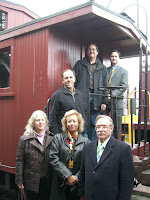 The Chapel Car Messenger of Peace earned City of Snoqualmie landmark status by a unanimous vote Thursday night. The King County Landmarks and Heritage Commission sitting as the City of Snoqualmie Landmarks Commission met on March 26 at the Conservation and Restoration Center to consider the Chapel Car nomination. [[Pictured at left are members of the King County Landmarks Commission: In the first row, from left to right, are Lauren McCroskey, Lynette Weber and Tom Hitzroth. Rick Chouinard is in the middle. On the platform of the 001 Caboose are Steve Day and Brian Rich. Not pictured are Bob Weaver, Susan Ranf and Kathryn Merlino.]] Landmarks staff outlined the history and significance of the car and the public had an opportunity to testify. One speaker was noted railcar expert Glenn Guerra who was in town conducting a 4Culture-funded (from the Collections Care Program) condition assessment of the Chapel Car. Landmark status bestows recognition for the object’s significance and raises its public profile. A benefit of landmark status is eligibility for support from the Landmarks Rehabilitation program administered by 4Culture.
The Chapel Car Messenger of Peace earned City of Snoqualmie landmark status by a unanimous vote Thursday night. The King County Landmarks and Heritage Commission sitting as the City of Snoqualmie Landmarks Commission met on March 26 at the Conservation and Restoration Center to consider the Chapel Car nomination. [[Pictured at left are members of the King County Landmarks Commission: In the first row, from left to right, are Lauren McCroskey, Lynette Weber and Tom Hitzroth. Rick Chouinard is in the middle. On the platform of the 001 Caboose are Steve Day and Brian Rich. Not pictured are Bob Weaver, Susan Ranf and Kathryn Merlino.]] Landmarks staff outlined the history and significance of the car and the public had an opportunity to testify. One speaker was noted railcar expert Glenn Guerra who was in town conducting a 4Culture-funded (from the Collections Care Program) condition assessment of the Chapel Car. Landmark status bestows recognition for the object’s significance and raises its public profile. A benefit of landmark status is eligibility for support from the Landmarks Rehabilitation program administered by 4Culture.
Built to bring religion to communities in a self-contained mobile church with living quarters, the chapel car did that and more. This church on wheels – and twelve others similar in design operated by the American Baptists, Catholics, and Episcopalians – brought modern evangelism and civility to disparate communities that sprung up across the West. Frontier towns were far apart and roads were almost nonexistent. There were very few of today’s transportation alternatives and for most communities the only viable access was by rail. (The chapel car concept appears to have been adapted from the chapel cars developed in the 1880s by the Russian Orthodox Church to serve remote communities across Siberia. Click here to see some images of Russian chapel cars from the 1880s through modern times.)
Culturally significant to the City of Snoqualmie, the Snoqualmie Valley, King County, Washington State and the entire United States as a Nationally-significant property, the Messenger of Peace ran on the Museum’s track right by the Snoqualmie Depot on a visit to North Bend over 92 years ago. It played a critical role in the settlement and development of this area by fostering the formation of religious congregations, renewing those that waned, and promoting religion (Christianity) in far flung communities across the west.

